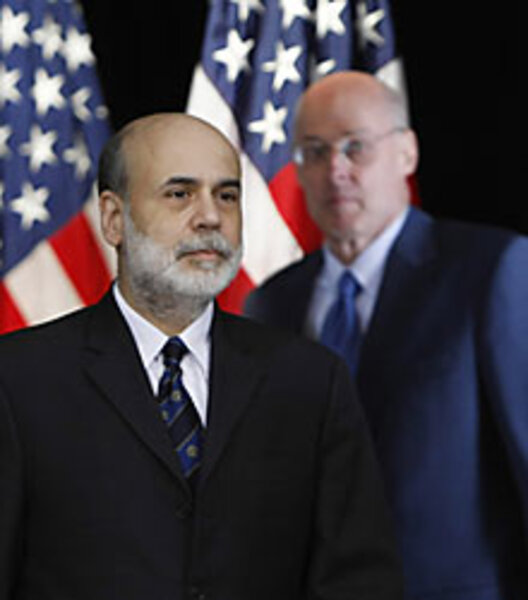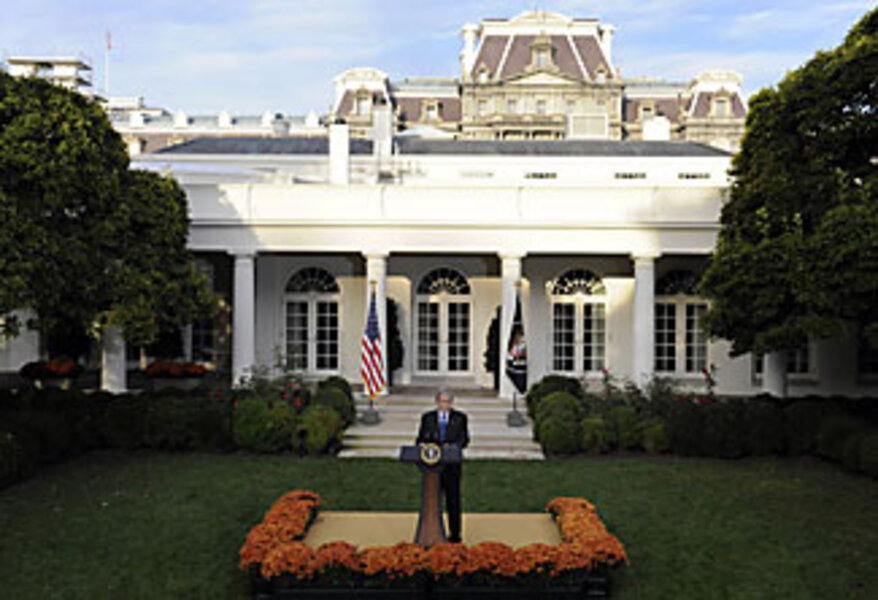Credit crisis overturns free-market ideology
Loading...
| Washington and New York
George W. Bush, meet Franklin Delano Roosevelt.
With its sudden and sweeping plan to pump $250 billion directly into America's banking system, a Republican administration in essence may have opted for a New New Deal, intervening in private markets to an extent not seen since the days of the Great Depression.
The world financial system remains so fragile that a free-market-oriented White House felt it had no choice but to resort to this partial nationalization. Now the actions of the next administration will determine whether the move is temporary or a turning point in the US government's attitude toward laissez-faire economics.
"You do what you have to do. It will be judged by its long-term consequences," says says Bruce Bartlett, a former economic adviser to Presidents Ronald Reagan and George H.W. Bush.
The move was the latest, and the biggest, in a long series of rescue attempts taken by the administration and the US Federal Reserve over the last several weeks in the wake of extreme stock market volatility and frozen credit markets.
President Bush announced the new plan in televised remarks before the opening of the New York Stock Exchange on Tuesday. He and his economic team described the bank intervention as something intended to preserve the free market, not bury it.
Their distaste for the partial nationalization was obvious. Only weeks ago, Secretary of the Treasury Henry Paulson explicitly rejected in a congressional appearance the notion of injecting funds directly in banks. Now he was proposing that same thing.
"We regret having to take these actions," Secretary Paulson said. "Today's actions are not what we ever wanted to do – but today's actions are what we must do to restore confidence in our financial system."
Under the new multifaceted stabilization program, the government will initially buy stocks in major US banks. Nine banks have agreed to participate. Smaller banks and thrifts will also be able to get involved in the federal buy-up program.
When financial markets stabilize and recover, the banks are expected to buy the stock back from the government, according to administration officials.
In addition, the Federal Reserve announced it will begin buying vast amounts of commercial paper on Oct. 27. This short-term debt is a crucial form of funding that many companies use to pay workers and buy supplies.
Clearly, the US government is moving to try anything and everything it thinks might work to keep the country and the world from falling into a deep recession.
"Our strategy will continue to evolve and be refined as we adapt to new developments and the inevitable setbacks," said Fed Chairman Ben Bernanke.
The US purchase of bank stock isn't exactly unprecedented. In the 1930s, under Roosevelt, the Reconstruction Finance Corp. both made loans to distressed banks and bought into them directly.
In World War I, Washington seized railroads to ease movement of troops and military supplies. Key industries were similarly nationalized in World War II. All were returned to owners when combat ended.
In 1952, President Truman seized the steel mills, lest a crippling strike hurt the Korean War effort. The Supreme Court eventually ruled that the nationalization was an unconstitutional abuse of power.
This time, the administration was worried that its just-passed $750 billion plan to buy bad mortgage-based assets was not calming financial markets. Last week's stock plunge was so bad – the worst ever one-week fall of the Dow Jones Industrial Average – that officials felt they had to go further.
"It's the least bad of the choices they faced," says Gerald O'Driscoll Jr., who until last August was vice president of the Federal Reserve Bank of Dallas.
Mr. O'Driscoll, now a fellow at the free-market-oriented Cato Institute, finds the bailout to be distasteful. He does believe that it addresses the root problem of the freeze in bank lending, however.
"Hopefully, this will bring in more private capital [to the banking system]," he says.
For some conservatives, the important thing is what happens next. If the government backs out soon, "everything's fine," says Mr. Bartlett, the economic adviser. If the US presence in banks becomes a more or less permanent feature of the economy, however, with government officials sitting on boards or steering decisions in other ways, things could turn negative, according to Bartlett.
"Remember, rent control in New York City was enacted as a temporary measure in World War II. These things have a tendency to evolve the longer they stay in place," he says.
Although the Dow Jones Industrial Average rose 936 points on Monday, some investment professionals would not be surprised to see the stock market retest its lows. "It's going to act like a bouncing ball," says John Lekas, president of Leader Capital Corp., a money management firm in Portland, Ore. "We could see the Dow move up to 11000 then move back to 8000 then back to 10500."
• Material from the Associated Press was used in this report.






